Table of contents
- Endurance test final balance of the Yamaha XJ6 Diversion Disassembled after 50,000 kilometers
- Readings
- Balance after 50,000 kilometers
- Costs and maintenance
- Yamaha takes a stand
- Reading experiences
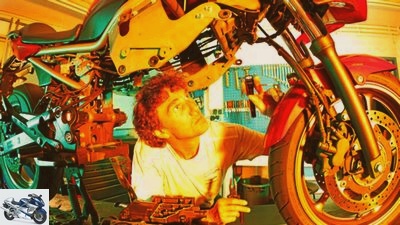
archive
motorcycles
Endurance test final balance (50,000 km): Yamaha XJ6 Diversion
Endurance test final balance of the Yamaha XJ6 Diversion
Disassembled after 50,000 kilometers
When viewed in the light, some bikes turn out to be cases for the workshop. The Yamaha XJ6 in the long-term test, too, but only for assembly and driving on.
Peter Mayer
11/25/2010
A single look can sometimes say more than a thousand words, namely that of the registration statistics. The documents the success story of Yamaha XJ6 series in the past two years quite unpathetically sober, but all the more impressive: While the completely redesigned mid-range all-rounder immediately took fifth place in the sales hit list in the 2009 season, enthusiasm for the four-cylinder increased even further in 2010 . Third place in the charts behind the long-running BMW R 1200 GS and Suzuki Bandit 1250 and thus the unofficial title of the most popular 600cc motorcycle – the Yamaha product planners obviously hit the nerve of the local bikers. The MOTORRAD editorial team too. Because the one that was added to the long-term test fleet in May 2009 XJ6 Since then, Diversion has shone for one thing above all: absence. It took only 16 months for the little red one to unwind 50,000 kilometers.
Buy complete article

Endurance test final balance
Disassembled after 50,000 kilometers: Yamaha XJ6 Diversion
8 pages) as PDF
€ 2.00
Buy now
A good sign. Ultimately, the Yamaha impressed on after-work jaunts, on vacation trips, and even won the group in the all-rounder classification at the 2009 MOTORRAD Alpenmasters. It is this universality that appears again and again in the entries in the logbooks. Starting with the moderate seat height (79 centimeters) or the comfortably tuned chassis to the silky smooth running four-cylinder with high torque for this displacement class – the XJ received verbal strokes again and again. Only colleagues who were hungry for adventure complained about boredom in the saddle, thus describing the downside of the running culture of this typical Japanese inline four-cylinder, which is similar to an electric motor. Arguments that have a rather irrational background given the hardly different performance of the XJ compared to other 600 concepts such as the ER-6 models from Kawasaki (parallel twin) or the Suzuki Gladius (Vau-Zwo).

Bilski
Good and cheap: It is no coincidence that the Yamaha XJ6 Diversion holds third place in the registration statistics for 2010.
The XJ6 hardly showed any specific weaknesses. The main problem was the gearbox that was stubbornly shifting from day one. Especially in city traffic, when shifting down several gears quickly – for example when approaching a red traffic light – the gearshift mechanism got stuck between the gears. Often it was only possible to click into neutral or first gear after a slight disengagement. New clutch plates and springs (material costs: 223.98 euros) as part of the 30,000-kilometer inspection brought improvement, but did not change anything in the Yamaha gears, which were basically very bony even after the change. The ignition lock also behaved more and more unruly. After 30,000 kilometers, the part occasionally went on strike and it became increasingly difficult to turn, so that fear of the XJ’s ignition key breaking off shortly before the gate closed at 48,700 kilometers resulted in a new lock on guarantee. Ultimately, a nose of the lock that was probably sanded off by dirt and vibrations emerged as the cause.
Speaking of inspections: with maintenance intervals of 10,000 kilometers, the Yamsel is up to date, but the inspections made a significant contribution: 268 euros for inspection and oil change at 10,000 kilometers, 421 euros (oil change, oil filter, air filter, spark plugs) 20,000 kilometers, 258 euros (with oil change) for the 30,000 pit stop and 593 euros (oil change with filter, air filter, spark plugs, brake fluid change) for the 40,000 check. The worn brake pads (due after 37,800 kilometers) and two new chain sets (at 21,000 and 48,700 kilometers) were assembled by MOTORRAD workshop manager Gerry Wagner, the second light figure in the opening photo.
Just like the various accessories for the XJ that MOTORRAD tested as part of the interim report (issue 9/2010). The Variotouringscreen windshield from MRA (119.90 euros) provided significantly improved wind protection. The Wilbers Monoshock (449 euros) did a much more efficient job than the serial shock absorber, which was underdamped especially for two-person operation. The tire recommendation was clearly in favor of the very neutral steering Conti RoadAttack 2.
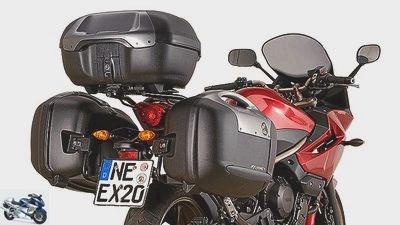
mps photo studio
Yamaha does not approve the XJ6 for a hard shell luggage system.
When choosing the luggage system, the XJ6 owner has to deal with a special case. In the accessories program for the XJ6, Yamaha only offers a top case and a softbag. Reason: a not explicitly quantified limitation of the maximum load on the frame rear. Baggage system providers such as Hepco & Becker see it differently. Obviously right. The subframe survived the frequently used maximum load of the system used by MOTORRAD over a long period of time.
Harmless – this adjective aptly describes the condition of the XJ6 after 50,000 kilometers. All engine internals were in first-class condition after dismantling. The slight grooves in the cylinder and even the clearly visible tracks in the shells of the crankshaft bearings have no effect on the bearing play. Not even the valve seats of the high-revving engine showed significant signs of wear.
All measured values were within the installation or operating tolerance. Even the rubbing marks on the gearshift forks or the pressure marks on the gearshift star were so minimal that they are out of the question as the cause of the aforementioned unstable gear shifting. An impressive balance that also applies to the chassis. Apart from a small rust spot on a mounting plate, the tubular steel frame cuts a dazzling figure. No corrosion, no areas worn bare by wiring harnesses, the paint on the tank and paneling parts show only minor signs of use – a great deal of effort has been taken at Yamaha in the processing. Only the bench that has sagged after many hours in the saddle should be padded again at a relevant company (www.kahedo.de; www.alles-fuern-arsch.de). A result that one would not necessarily have expected against the background of the razor-sharp tariff.
Because with a list price of 7095 euros including standard ABS, the Diversion also hits the nerve of customers financially. Who can choose between three editions of the XJ anyway. With a share of 47 percent, almost half of the XJ fans choose the pure naked bike, 41 percent appreciate the wind protection behind the half-shell of the Diversion, while twelve percent go for the fully disguised “F” model.
The fact that the little Yamaha is now doing so well as a long-distance runner has given the XJ6 the accolade – objectively documented by the sensational second place in the overall ranking of all MOTORRAD endurance test machines. So that not only for reader Martin Dinjer from Berlin (see reader experiences) is certain: With the XJ6 you get one thing above all – a hell of a lot of motorcycle for the money.
the Yamaha XJ6 Diversion is broken down:
Readings

Drawing: archive
Good in the forage: The engine and driving performance could not harm even 50,000 kilometers.
| Initial / final measurement | 3398 km | 50040 km | ||
| acceleration | 0-100 km / h | sec | 3.9 | 3.9 |
| 0-140 km / h | sec | 7.3 | 7.3 | 0-200 km / h | sec | 26.9 | 26.7 |
| Draft | 60-100 km / h | sec | 5 | 4.7 |
| 100-140 km / h | sec | 5.4 | 5.2 | 140-180 km / h | sec | 7.7 | 7.4 |
| Average fuel consumption over 50,000 km | Fuel (normal) | l / 100 km | 5.4 | |
| Engine oil | l / 1000 km | – |
Balance after 50,000 kilometers
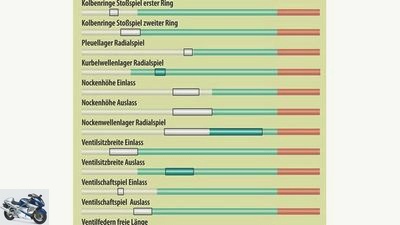
Drawing: archive
The wear values of the Yamaha XJ6 Diversion.
State
Cylinder head: All valves close tightly, the valve stem clearance is within the installation tolerance, only the exhaust valve seats are slightly wider. The camshafts are also in excellent condition apart from a slightly increased bearing play.
Cylinder / piston: The cylinders are in very good condition apart from a few harmless running marks. The pistons do not show any unusual wear either, as do the piston rings. The piston running clearance is still within the installation tolerance.
Crank drive: The crankshaft main bearings have an uneven contact pattern, but the radial play is okay. Connecting rod bearings and piston pin bearings show no abnormalities.
Power transmission: The new clutch plates as well as the clutch basket and hub show hardly any signs of wear, as do the gear wheels. On the star plate of the shift drum there are pronounced detent tracks at the idle position, harmless tracks on the shift forks.
Frame / chassis: There is some rust on a welded mounting plate on the frame, otherwise add-on parts, paintwork and chassis are in good condition.
Costs and maintenance
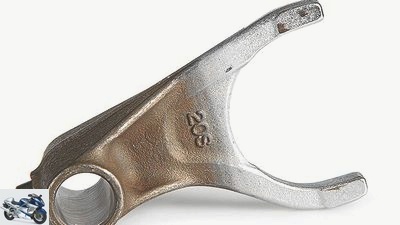
archive
Even if the tracks on the shift forks are minimal, the XJ6 shifted stubbornly from day one.
Operating costs over 50,000 kilometers:
12.5 liters of oil at 14.62 euros, 182.75 euros
3 oil filters at 10.85 euros each 32.55 euros
2 air filters at EUR 31.01 each EUR 62.02
8 spark plugs at 8.25 euros each 66.00 euros
1 set of rear brake pads at 36.59 euros 36.59 euros
2 sets of front brake pads at 30.05 euros each 60.10 euros
1 set of clutch linings with springs 223.99 euros
2 chain sets at 161.30 euros each 322.60 euros
Brake fluid 8.87 euros
Small parts, lubricants 35.39 euros
Seals 3.19 euros
Inspections and repairs 1426.32 euros
Tires (including assembly, balancing and disposal) 1350.00 euros
Fuel 3708.37 euros
Total costs 7518.74 euros
Acquisition costs 7065.00 euros
Loss of value 2865.00 euros
Estimated price (dealer selling price) 4200.00 euros
Costs per kilometer (without depreciation) 15.0 cents
Costs per kilometer (with depreciation) 20.8 cents
Maintenance and repair costs (mileage):
Rear tire renewed (Dunlop Roadsmart) 10432
Front and rear tires renewed (Metzeler Roadtec Z6) 19221
Taillight bulb and chain set renewed 20967
Clutch discs and springs renewed 29800
Front and rear tires renewed (Pirelli Angel ST) 30954
Bulb turn signal renewed 35102
Brake pads front and rear as well as taillight bulbs renewed 37734
Front and rear tires renewed (Dunlop Roadsmart) 40000
Clutch cable renewed 40907
Chain set and ignition lock renewed 48698
Yamaha takes a stand
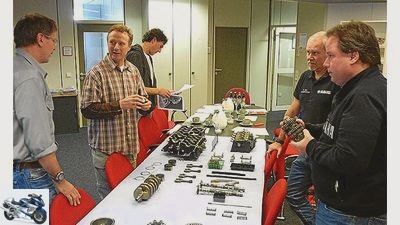
archive
Parts report: The MOTORRAD men Thole, Mayer, Wagner as well as Karlheinz Vetter and Ralf Keller (from left) from Yamaha.
…to the radial play of the camshaft main bearings above the installation tolerance. The camshaft bearing is slightly above the level of the installation tolerance, but within the operating tolerance. There is therefore no need for action here. That is an excellent result and one can be more than satisfied with it.
…to the notches / notches in the gearshift star of the gearshift drum. The notches are completely normal for this mileage, even rather minor, and so there is no cause for concern.
…to the increased cooling water temperatures, sometimes up to 105 degrees, when driving in high mountains. With the XJ6, “high” temperatures only start at 117 degrees Celsius. Even with this brand, everything is still OK. This is also described in the operating instructions for the XJ6. The warning lamp in the display also only starts to light up at this temperature. According to MOTORRAD, however, the engine never reached this temperature range, so that the whole thing could at best be described as an “elevated temperature”, i.e. absolutely uncritical.
…to the clutch disks, which were worn out unusually early and were replaced at 30,000 kilometers. The clutch wear is not normal for this mileage and cannot be fully explained to us. Perhaps the hard test operation has led to a bit more wear and tear here.
…to the ticklish-to-use ignition lock that was replaced shortly before the end of the endurance test. Our assumption is that various influencing factors may have led to the problem. Perhaps dirt has penetrated the lock and then the key in the lock has worn away material due to slight vibrations, which then caused this damage. This may have been supported by a key fob that amplified the vibration impulses. The lock was replaced on guarantee.
…to the recommendation not to add a luggage system. The XJ6 is an all-rounder, not a tourer. That is why the motorcycle was designed to only use softbags and a topcase. Yamaha’s liability is also limited to loading with this luggage equipment.
Reading experiences

archive
Klaus Maier from Appenweier on his Yamaha XJ6 Diversion.
For years I was at home in the Ballermann group (single cylinder, 650 cm³) before I switched to the organ player. And I’m thrilled – even if I still have to get used to the high notes. One of the most beautiful features of the XJ6 was confirmed to me during a ride with a representative of the macho faction from Milwaukee. At first with a mild smile, after a few hundred kilometers, impressed by the lightness of being … er driving, he had to admit: Wow, that doesn’t work with mine! Conclusion: The looks of the girls were on his side, the driving pleasure on mine.
Klaus Maier, Appenweier
I unwound about 13,000 kilometers with the XJ6 Diversion. Apart from the two scheduled inspections, it saw no workshop. In the case of the 10000, the rust on the seat holder was removed and re-sealed without any problems. I switched from a Suzuki GSX 750 because I wanted to ride a lighter motorcycle. I don’t miss a single horsepower on the GSX’s 92 horsepower. The seating position is particularly pleasing. 2000 km of winding roads in Corsica speak a clear language without any difficulties, and she has even mastered gravel passes without complaint.
Dirk Wunsch with partner, Giessen
I often use the bike to go to the office. In addition to the usual tours, I spent a motorcycle holiday in the Pyrenees. The machine is easy to use in urban areas. It’s almost like driving an automatic motorcycle. The chassis set-up is well done. If you choose a dynamic driving style, you quickly notice that the chassis is reaching its limits. If you are looking for a weak point, the bony gear must be addressed first and foremost. The XJ 6 is a classic single motorcycle. A ride with a pillion passenger is actually not her thing. Conclusion: For me, the Yamaha XJ 6 is really a big hit!
Theo Schmitz, Cologne
I bought my XJ6 Diversion in April 2010. Without ABS but new and from the dealer for a hammer price of 5600 euros. A hell of a bike for your money! The overall impression: the steel swingarm and the telescopic fork are obviously not the most beautiful, but for the price … Engine: The small 600 pushes the motorcycle forward sufficiently. Only when riding with a pillion do you have to shift down a gear more often. The sound could be better. Sitting comfort: I sat on it and felt comfortable. Long distance: great in solo operation. The pillion can withstand up to 300 kilometers. Nobody needs more motorcycles!
Martin Dinjer, Berlin-Koepenick
I bought the machine after 20 years of abstinence from motorcycling. Before that, I looked at the Suzuki Bandit, the Kawasaki ER-6f and the Honda CBF 600. During the test drive, I was impressed by the handiness of the XJ. There were worlds between her and the rest of the world. I wouldn’t have wanted to do anything else on a little alpine tour. Sometimes I almost get the impression that my XJ knows the right line better than I do. So far there have been no technical problems. Unfortunately, none of the Yamaha developers gave any thought to luggage. The lack of attachment points for soft luggage or a suitcase system that matches the design are really weak points.
Hans-Peter Steiert, Boeblingen
Looking for a comfortable, economical machine suitable for touring in the all-rounder segment. The Suzuki Bandit was too old-fashioned for me, the ER-6f from Kawasaki too spartan and the Honda CBF 600 too normal (everyone’s motorcycle). Since then I have driven almost 10,000 km without any technical problems or signs of wear. Dozens of tours through Berlin / Brandenburg, Saxony and the Harz Mountains were a lot of fun. A really successful motorcycle. Plus points: ride comfort, consumption (on average 4.3 liters), engine (smoothness) and even the often described unsuitability for a passenger could not be discovered on my machine so far.
Roberto Schonberg, Berlin
Related articles
-
Endurance test final balance Honda CBF 1000
Bilski motorcycles Endurance test final balance Honda CBF 1000 Endurance test final balance Honda CBF 1000 CBF 1000: Balance & Video Screw on, look at,…
-
Endurance test interim balance of the Yamaha XJ6 Diversion
fact motorcycles Endurance test interim balance of the Yamaha XJ6 Diversion Endurance test interim balance: Yamaha XJ6 Diversion Yamaha’s 600 all-rounder…
-
Endurance test final balance: Yamaha YZF-R 125
jkuenstle.de motorcycles Endurance test final balance: Yamaha YZF-R 125 Endurance test final balance: Yamaha YZF-R 125 The Yamaha YZF-R 125 after its…
-
Endurance test final balance: Honda Fireblade
Bilski motorcycles Endurance test final balance: Honda Fireblade Endurance test final balance of the Honda Fireblade Conclusion after 50,000 test…
-
Endurance test final balance BMW F 800 S
mps photo studio motorcycles Endurance test final balance BMW F 800 S Endurance test final balance BMW F 800 S They kissed and they hit her Andreas Bildl…
-
Endurance test final balance Honda NC 700 S
Photo: www.r-photography.info 54 pictures www.jkuenstle.de 1/54 the Honda NC 700 S is a solid companion – not just for beginners. Gargolov 2/54 It was…
-
Endurance test interim balance: engine damage in the endurance test BMW K 1300 GT
j.kuenstle.de counselor technology & future Endurance test interim balance: engine damage in the endurance test BMW K 1300 GT Endurance test interim…
-
Endurance test interim balance of the Honda CBF 1000
Artist motorcycles Endurance test interim balance of the Honda CBF 1000 Endurance test interim balance of the Honda CBF 1000 The blue mouse Nothing. Just…
-
Endurance test interim balance for the Suzuki Bandit 1250 S
motorcycles Endurance test interim balance for the Suzuki Bandit 1250 S Endurance test interim balance for the Suzuki Bandit 1250 S The one without…
-
Endurance test final balance Hyosung
Bilski motorcycles Endurance test final balance Hyosung Endurance test final balance Hyosung Hyosung GTR 125 R It looks like its sister GT 650 R, but is…